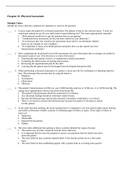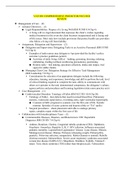Chapter 21. Physical Assessment
Multiple Choice
Identify the choice that best completes the statement or answers the question.
____1.A nurse wakes the patient for a focused assessment. The patient, trying to rest, tells the nurse, “I wish you would quit waking me up. Do you really need to keep bothering me?” The nurse appropriately responds:
1.“Most patients would love to get the attention that you are getting.”
2.“I understand your frustration, but this has been ordered by your physician.”
3.“It is necessary that I do a head-to-toe assessment from which I can determine whether there are any changes in your condition.”
4.“It is important to assess your blood pressure and pulse since we just started your new blood pressure medicine.”
____2.After completing the initial head-to-toe shift assessment, the nurse determines that no changes are needed in the patient’s plan of care. This decision is a result of the nurse’s
1.Ensuring that each patient receives a comprehensive health assessment.
2.Evaluating the effectiveness of nursing interventions.
3.Reviewing the organizational plan for the shift.
4.Learning that the patient may be discharged from the hospital during this shift.
____3.When performing a physical assessment of a patient, a nurse uses the five techniques of obtaining objective data. The technique that provides data by using the hands is
1.Palpation.
2.Auscultation.
3.Observation.
4.Olfaction.
____4.The patient’s blood pressure at 8:00 a.m. was 124/80 mm Hg, and now at 12:00 p.m., it is 152/94 mm Hg. The
charge nurse appropriately instructs the newly hired nurse that
1.The patient’s blood pressure should be rechecked in 15 minutes.
2.Any abnormal findings should be rechecked within 8 hours.
3.Because the blood pressure has become elevated, it should be rechecked in 1 to 2 hours.
4.There is no reason to recheck the blood pressure because this pattern of elevation is typical for this patient.
____5.At the staff education meeting, the nurse explains that it is important to use four senses (sight, touch, hearing, and smell) to determine whether a patient is exhibiting signs of illness or injury. These signs of illness or injury are
1.Subjective.
2.Measurable.
3.Reported by the patient.
4.Hidden.
____6.The nurse takes additional time getting to know a patient admitted for surgery because
1.The patient may not fully cooperate with the nurse otherwise.
2.It is important that the nurse be prepared to answer any questions that the family may have about the patient.
3.The nurse believes that a patient responds better if she and the patient are on a first-name basis.
4.The nurse believes that establishing rapport with a patient leads to a trusting nurse-patient relationship.
____7.The nurse correctly uses percussion when assessing the patient for
1.Hyperinflated lungs.
2.An enlarged heart.
3.A heart arrhythmia.
4.Rebound tenderness.
____8.The nurse charts that the patient is eupneic. This finding indicates that respirations
1.Require the use of costal, sternal, and subclavicular muscles.
2.Are very shallow and at a rate between 8 and 12 per minute.
3.Are between 20 and 24 per minute and that the patient is using his thoracic muscles.
4.Are considered to be normal in depth and rate with use of the abdominal muscles.
____9.A 75-year-old patient is breathing at a rate of 30 and denies dyspnea. The breath sounds are clear to auscultation in all five lobes. The nurse will further assess the patient’s respiratory and circulatory systems by checking capillary refill. A normal finding would be
1.Nail beds pink, capillary refill 6 seconds.
2.Nail beds cyanotic, capillary refill 4 seconds.
3.Nail beds pink, capillary refill 5 seconds.
4.Nail beds blanched, capillary refill 3 seconds.
____10.The nurse gives the patient the following instructions: “Focus on my pencil and follow it as I move it away from you and then back toward you.” The nurse is assessing the
1.Anisocoria of the patient’s pupils.
2.Patient’s accommodation response.
3.Patient’s consensual reflex.
4.Direct pupil response of the patient.
____11.A patient who is one day postoperative is complaining of nausea and refusing to eat. Upon auscultation of the abdomen, the nurse finds that the patient’s bowel sounds are hypoactive. This is most likely due to
1.Peritonitis.
2.A bowel obstruction.
3.Anesthesia.
4.Paralytic ileus.
____12.The initial assessment of a patient who was admitted with a gastrointestinal inflammatory disease revealed that the patient had hyperactive bowel sounds. The follow-up assessment finds that the bowel sounds are still hyperactive but are now audible without a stethoscope. The nurse will correctly chart:
1.“Low-pitched bowel sounds D.”
2.“Borborygmus noted.”
3.“Bowel sounds are high pitched.”
4.“Bowel sounds hyperactive D.”
____13.While assessing the feet of a 72-year-old male patient with diabetes, the nurse noted that there were no cuts, cracks, or blisters. The patient stated, “I don’t have as much feeling in my feet as I used to.” The nurse correctly understands that the patient is most likely suffering from
1.Paresthesia.
2.Infection.
3.Lentigines.
4.Necrosis.
____14.The nurse correctly assesses a patient’s abdomen by following the sequence of 1.Inspection, palpation, and auscultation.
2.Palpation, inspection, and auscultation.
3.Palpation, auscultation, and inspection.
4.Inspection, auscultation, and palpation.
____15.During the physical assessment, the nurse asks an elderly female patient if she experiences constipation. The nurse knows that
1.Elderly patients almost always abuse laxatives, which creates problems with constipation.
2.Aging patients always have difficulty having a bowel movement while hospitalized.
3.In elderly patients, the rectal sphincter has lost elasticity, which decreases the sensation of urgency.
4.It is common for intestinal peristalsis to slow down as a person ages, causing problems with constipation.
____16.A female patient who was admitted after suffering a stroke becomes frustrated because she is unable to respond verbally to the nurse’s questions. The nurse, understanding the complications following a stroke, charts that the patient is
1.Dysphasic.
2.Dysphagic.
3.Aphasic.
4.Dyspneic.
____17.A nurse, preparing to auscultate breath sounds, correctly positions the patient in the most favorable position, which is
1.Supine position.
2.Low Fowler position.
3.Semi-Fowler position.
4.High Fowler position.
____18.A stable male patient, who was just admitted for left-lower-lobe pneumonia, tells the nurse that his cough is nonproductive. When assessing the patient’s breath sounds, the nurse suspects consolidation when, over the left lower lobe, she detects
1.Rales.
2.Absent breath sounds.
3.Stridor.
4.Rhonchi.
____19.A male patient has been admitted with congestive heart failure. Although the patient is sitting in a semi-
Fowler position, the nurse cannot auscultate distinct heart tones. The nurse will correctly first
1.Document that the heart tones are muffled.
2.Count the apical rate as best as possible and then document it.
3.Have the patient lean forward and toward his left side.
4.Report the findings to the charge nurse.
____20.A patient tells the nurse that the cardiologist has told her that she will likely need a mitral valve replacement in a few years. The nurse can best hear her mitral valve
1.Over the apex of the left ventricle.
2.At the second intercostal space to the right of the sternum.
3.At the second intercostal space to the left of the sternum.
4.At the fourth intercostal space just to the left of the sternum.
____21.When assessing the integrity of a patient’s skin, the nurse is
1.Checking the elasticity of the skin.





